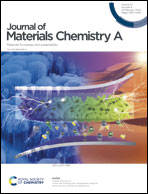Relevance of Ge incorporation to control the physical behaviour of point defects in kesterite†
Abstract
To reduce the prominent VOC-deficit that limits kesterite-based solar cell efficiencies, Ge has been proposed over the recent years with encouraging results as the reduction of the non-radiative recombination rate is considered as an approach to improve the well-known Sn-kesterite world record efficiency. To gain further insight into this mechanism, we investigate the physical behaviour of intrinsic point defects upon both Ge doping and alloying of Cu2ZnSnS4 kesterite. Using a first-principles approach, we confirm the p-type conductivity of both Cu2ZnSnS4 and Cu2ZnGeS4, attributed to the low formation energies of the VCu and CuZn acceptor defects within the whole stable phase diagram range. By doping of the Sn-kesterite matrix, we report the lowest formation energy for the substitutional defect GeSn. We also confirm the detrimental role of the substitutional defects XZn (X = Sn, Ge) acting as recombination centres within the Sn-based, the Ge-doped and the Ge-based kesterite. Upon Ge incorporation, we highlight, along with the increase of the XZn (X = Sn, Ge) neutral defect formation energy, the reduction of the lattice distortion resulting in the reduction of the carrier capture cross section. Both of these elements lead to a decrease of the non-radiative recombination rate within the bulk material following Sn substitution by Ge.



 Please wait while we load your content...
Please wait while we load your content...